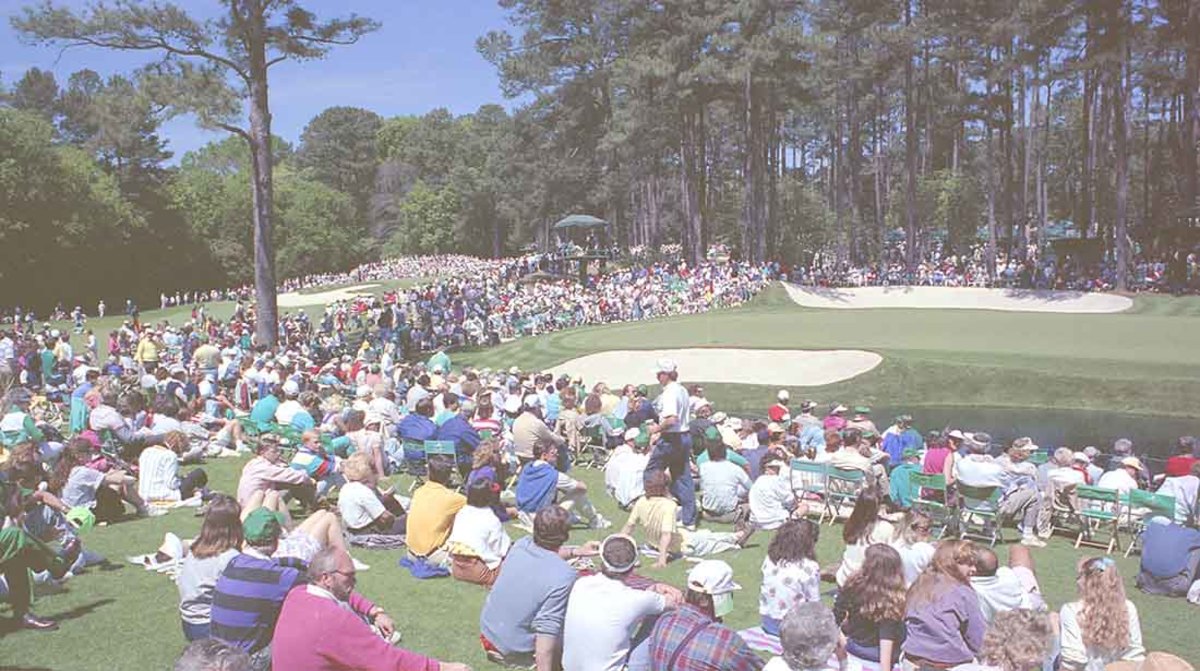Remembering a Meeting With Herbert Warren Wind on the Eve of the Masters
AUGUSTA, GA.— I first met Herbert Warren Wind, the legendary author and golf historian, under the big oak tree behind the Augusta National clubhouse. He was an old man in a tweed sports coat, and I was a neophyte golf writer from Kansas City. He was the author of The Story of American Golf, co-author of the Ben Hogan classic, Five Lessons: The Modern Fundamentals of Golf, and a soon-to-be member of the World Golf Hall of Fame. I, just so you’ll appreciate the context, was the author of The George Brett Story, editor of Dr. Sydney Garfield’s Teeth, Teeth, Teeth: The Incredible World of Teeth, and a basketball-playing member of the Overland Park Athletic Club.
What Mr. Wind and I had in common—aside from our serendipitous meeting at the 1990 Masters—was an employment history at Sports Illustrated. Herb—and I never called him that—was SI’s golf correspondent in its first decade, filing notoriously-long tournament stories that had bewildered editors asking, “What’s the connection between Jimmy Demaret and the fourth Duke of Wellington?” Herb—and it still doesn’t sound right—was so deadline-averse that the magazine gave him a full week to file his game stories. “Even that was too much pressure,” he told me under the tree, explaining his eventual move back to The New Yorker, where nobody cared if his U.S. Open essay, started in June, took three months to hit the newsstands.
I didn’t take notes that day, so my Herbert Warren Wind quotes must be treated as apocryphal. Nevertheless, I remember asking him about “Amen Corner,” his famous nickname for the 11th, 12th and 13th holes at Augusta National. He shook his head, expressing a certain befuddlement about the term’s enduring popularity, buried, as it had been, in the first paragraph of a somewhat legalistic account of the 1956 Masters, won by Arnold Palmer after a protracted debate with rules officials over an embedded-ball ruling. “The first phrase that came to mind was ‘hot corner,’” Mr. Wind told me, “but baseball owned that.”
Here, if it’s helpful, is the famous first paragraph from the April 21, 1958 issue of Sports Illustrated: “On the afternoon before the start of the recent Masters golf tournament, a wonderfully evocative ceremony took place at the farthest reach of the Augusta National Course—down in the Amen Corner where Rae’s Creek intersects the 13th fairway near the tee, then parallels the front edge of the green on the short 12th and finally swirls alongside the 11th green.” The original article, framed, hangs on a wall in the upstairs lobby of the Augusta National Press Building.
Mr. Wind never claimed that the term “Amen Corner,” was his invention. He picked it up from a jazz recording, “Shoutin’ in that Amen Corner,” that evoked emotional churchgoers responding to a fire-and-brimstone preacher. In a 1984 Golf Digest article, Wind provided granular details. “With plenty of time to think out the article,” he wrote—subtly winking at journalism’s deadline slaves—“I felt that I should try to come up with some appropriate name for that far corner of the course where the critical action had taken place. The only phrase with the word ‘corner’ I could think of (outside of football’s ‘coffin corner’ and baseball’s ‘hot corner’) was the title of a song on an old Bluebird record.”
All this is prologue to my own, long-overlooked contribution to Masters nomenclature. On April 6, 2012, I posted a golf.com column under the headline, AUGUSTA NATIONAL’S NEWEST HAZARD: THE ROOKERY.” Here’s the lede to that story:
They call it “the Rookery,” that nasty nest of trouble down the left side of Augusta National’s eighteenth hole. Tiger Woods took an unplayable there on Thursday and had to settle for bogey. Temporary first-round leader Henrik Stenson took his own unplayable, topped his next shot off the pine needles and wound up making a quadruple-bogey 8. Today, I was trying to decide between a bag of M&M peanuts and a packet of Pepto-Bismol when the tee shot of Scott Stallings came crashing through the trees and settled up against the green fence that separates tall-pine prison from concession-stand bliss. “I didn’t even know there was a building there,” Stallings admitted afterwards, happy to have escaped with a scrambling par.

Herbert Warren Wind fans would have recognized my transparent effort to match him in the nicknaming department, but I made it clear even to the unenlightened by…well, by confessing. “I coined that nickname at around four o’clock this afternoon,” I wrote, “when hundreds of starlings were making an uproar in the shrubs before launching themselves en masse and swooping and darting up the hill toward the clubhouse.” I added that Left-of-18 already had a nickname, “but one that is not fit for a family website because it references a well-known pro who for years has been interrupting his march up eighteen to step into the Rookery and relieve himself behind a bush.”
That’s glib, but there was substance to my column. In two decades covering the Masters, I had never really considered the woods left of the 18th fairway; it was the trees on the right that destroyed pros’ dreams—e.g., Tom Watson in the 1991 Masters, won by left-aiming Ian Woosnam. But the hole had changed. Course doctor Tom Fazio had pushed the tee way back, creating a tight driving corridor, and the trees had grown, as trees will do. Thus, in a two-day span, you had Woods, Stenson and Stallings blazing trails in a glade worthy of the Brothers Grimm. “That’s three examples,” I wrote, “of why the Rookery makes players’ hands shake when they try to put the ball on the peg on the eighteenth tee.”
Reading my piece 11 years later, I’m struck by this passage, which I think Mr. Wind would have liked:
Situated at the uphill end of a long, narrow corridor of pines, the Rookery is the venus flytrap of hazards. One tree in particular leans into the fairway to snatch drives in mid-flight, consigning the purloined balls to a deeply-shaded glade filled with dense shrubbery and necking teenagers. The Rookery is where Gary McCord’s body bags were dumped when they ran out of room behind the seventeenth green.
Ah, well. Like Icarus—who would never have been so dumb as to mention the famous body bags—I flew too close to the sun. No writer or commentator has cited the Rookery in the past decade, and I have been provided no licensing opportunities by mug makers or apparel firms. If Tiger Woods wins another Masters by holing out from the trees left of 18, I’m sure SI’s Michael Rosenberg will report that the miracle shot was struck “not far from Amen Corner.”
But give me this. I penned my opus in a couple of hours. It took Mr. Wind a week.
